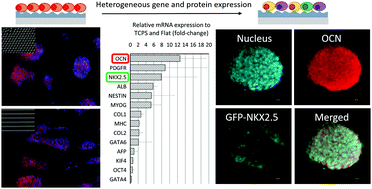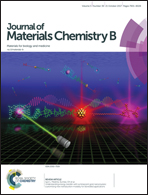Heterogeneity of mesenchymal and pluripotent stem cell populations grown on nanogrooves and nanopillars†
Abstract
Surface nanotopographies are an important way of mimicking the stem cell niche on biomaterial surfaces. Previous studies have focused on the differentiation of stem cells into a defined lineage using nanotopographies, but they have rarely considered the homogeneity of cell populations produced. We examined the impact of two types of substrates (i.e. nanogrooves and nanopillars made by soft lithography) on the surface-induced differentiation of human amniotic membrane-derived mesenchymal stem cells (hAM-MSCs) and mouse embryonic stem cells (mESCs) without the use of additional chemical induction medium components. Cell morphology and proliferation were analysed at day 1 and day 3. Gene expression was analysed at day 14 for hAM-MSCs and at day 7 for mESC-derived embryoid bodies (mEBs) using quantitative real-time polymerase chain reaction (qPCR). The substrates with nanogrooves had a noticeable effect on cell alignment in a depth dependent manner with both cell types showing strong alignment along the deep grooves. On the other hand, the nanopillar substrates showed inhibition of cell spreading for both cell types. The nanogrooves showed inhibition of hAM-MSC growth but enhanced mEB proliferation, especially on the deeper grooves. The nanopillars did not significantly affect hAM-MSC growth, but can modulate mEB growth depending on the pillar density, indicating that mEBs are more sensitive to nanotopographies in terms of proliferation, while hAM-MSCs are only sensitive to specific structures and sizes. Genes associated with bone, cartilage, and fat were investigated for hAM-MSCs, whereas genes of the endoderm, mesoderm, ectoderm, and pluripotency were investigated for mEBs. In general, gene expression for hAM-MSCs was not enhanced significantly by the nanotopographies compared to the flat control. On the other hand, genes of bone, cartilage, skeletal muscle, heart, and liver were up-regulated on both nanopillars and nanogrooves, especially OP65 (ordered pillars with 65% density) and SG40 (shallow grooves with 40 nm depth) in a feature size dependent manner. We found that a small portion of mEBs was composed of cardiac-like beating cells (i.e. GFP-NKX2.5 positive) and a bone cell marker (i.e. OCN) indicating a heterogeneous cell population being generated on those types of surfaces. This work highlights the importance of nanotopographies in stem cell differentiation and how studying multiple properties of the substrate and cells is needed as we strive to generate homogeneous and mature cell populations using biomaterials.



 Please wait while we load your content...
Please wait while we load your content...